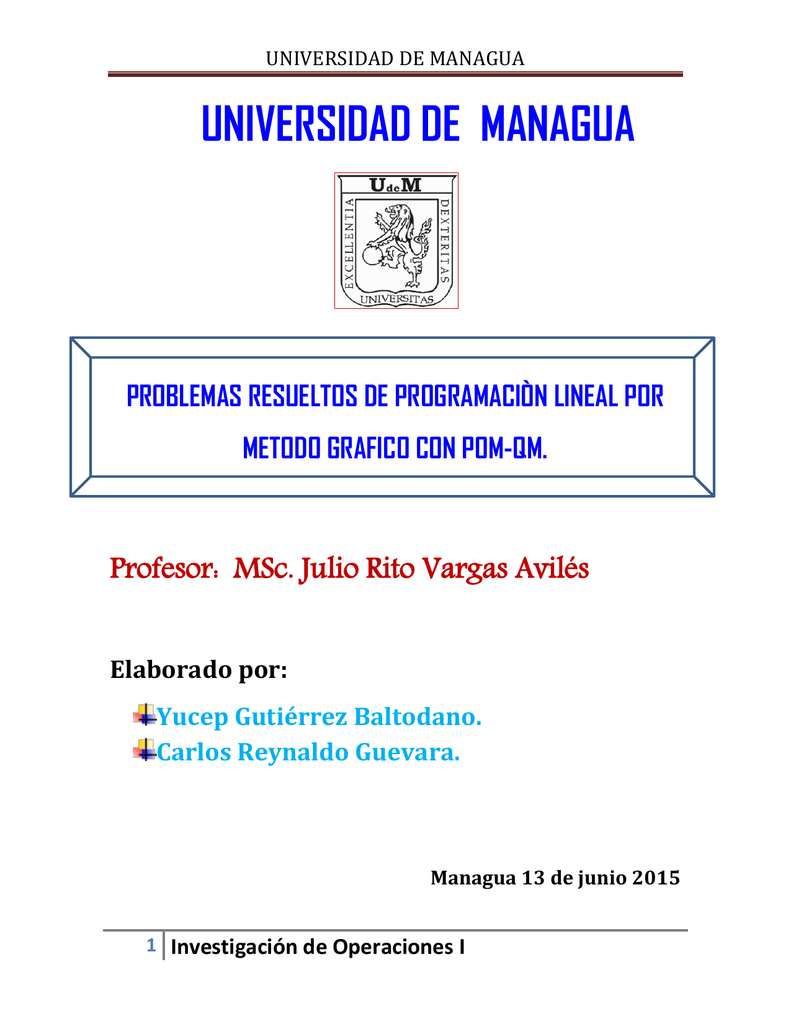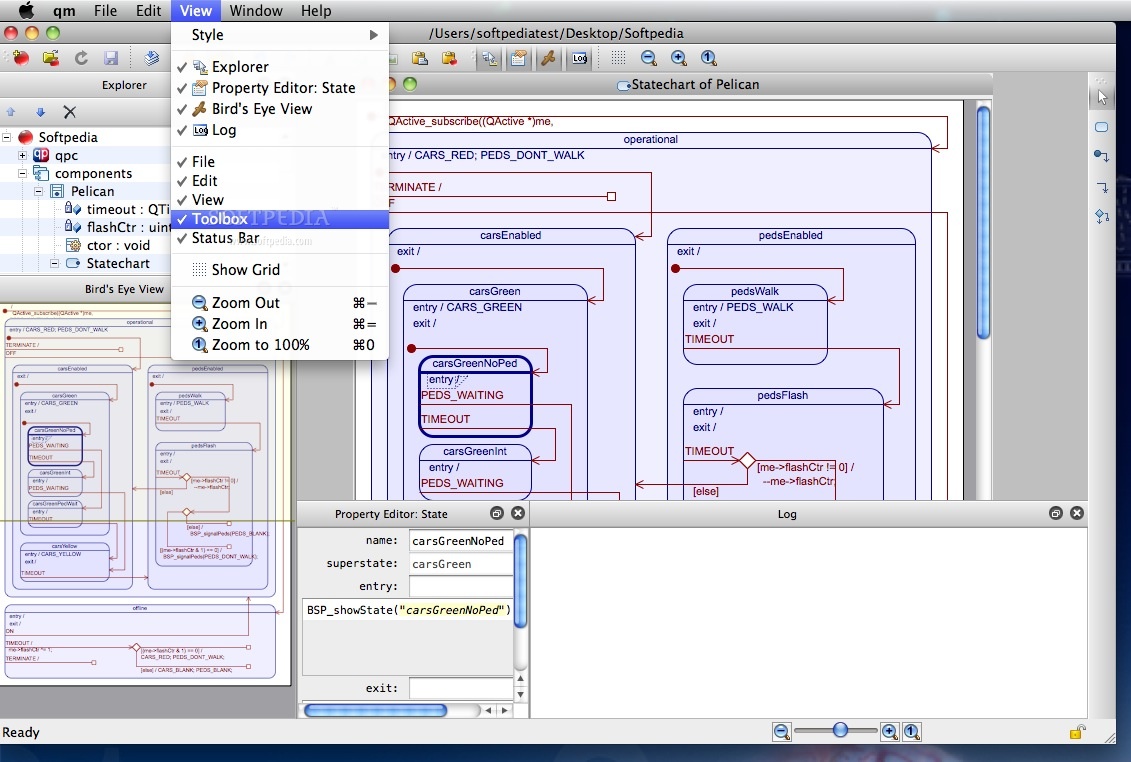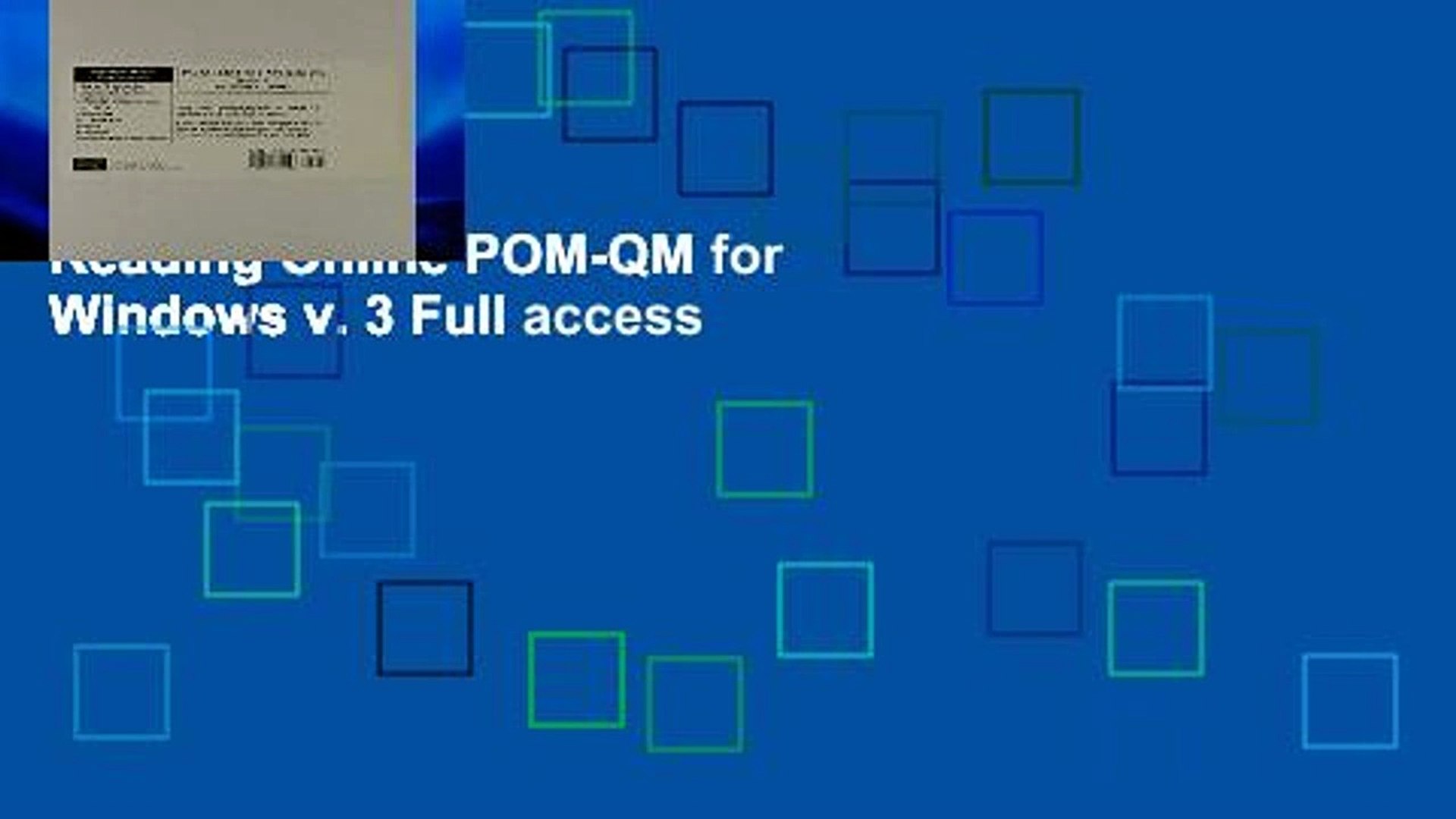Prentice-Hall – Shareware – Windows
Overview
Pom Qm V5
POM-QM for Windows is developed by Prentice-Hall and is used by 73 users of Software Informer. The most popular version of this product among our users is 5.3. The names of program executable files are normalv3.exe, pomqm3Start.exe, pomqmv3.exe, normalv4.exe and POM-QM for Windows 5.exe. May 02, 2021 POM-QM for Windows, 5.3 (latest) POM-QM for Windows, 5.0. No specific info about version 5.2. Please visit the main page of POM-QM for Windows, on Software Informer.
POM-QM for Windows is a Shareware software in the category Business developed by Prentice-Hall.
The latest version of POM-QM for Windows is currently unknown. It was initially added to our database on 10/22/2008.
POM-QM for Windows runs on the following operating systems: Windows.
POM-QM for Windows has not been rated by our users yet.
Pom-qm Linear Programming


Pom Qm 3
Write a review for POM-QM for Windows!

| 06/03/2021 | W10Privacy 3.7.0.8 |
| 06/03/2021 | WashAndGo 26.46 |
| 06/03/2021 | Wise Care 365 Free 5.6.7.568 |
| 06/03/2021 | FolderSizes 9.2.315 |
| 06/03/2021 | Total Uninstall 7.0.1 |

| 05/26/2021 | Chrome 91 update fixes vulnerabilities |
| 05/25/2021 | Free UpdateStar Packs to setup your computer software |
| 05/18/2021 | How to setup a VPN on a Windows computer using PureVPN for example |
| 05/16/2021 | Why you should think about using a VPN to protect your privacy |
| 05/11/2021 | Adobe fixes 43 vulnerabilities with May updates |
- » descargar qm for windows gratis español
- » pom qm windows 4 freedownload
- » qm pom download newest version
- » pom qom
- » pom qm application
- » pom qm for windows free download
- » pom for windows free download
- » qm for windows
- » pom-qm descargar
- » pom-qm windows phone

Preview only show first 10 pages with watermark. For full document please download
QM FOR WINDOWS Version 4 Software for Decision Sciences: Quantitative Methods. New Jersey.POM . Weiss www. .. Pearson Prentice Hall.com October 1. .... 131 Linear Programming . .... We are gratified by the response to the four previous DOS versions and three previous Windows versions of POM-QM for Windows.
Transcript
POM - QM FOR WINDOWS Version 4 Software for Decision Sciences: Quantitative Methods, Production and Operations Management Howard J. Weiss www.pearsonhighered.com/weiss [email protected] October 1, 2010Copyright (c) 2011 by Pearson Education, Inc., Upper Saddle River, New Jersey, 07458. Pearson Prentice Hall. All rights reserved.Table of Contents Chapter 1: Introduction Overview ............................................................................ 1 Hardware and Software Requirements .............................. 3 Installing the Software ....................................................... 4 The Program Group ........................................................... 5 Starting the Program .......................................................... 6 The Main Screen ................................................................ 7Chapter 2: A Sample Problem Introduction ...................................................................... 12 Creating a New Problem .................................................. 13 The Data Screen ............................................................... 15 Entering and Editing Data................................................ 15 The Solution Screen ......................................................... 17Chapter 3: The Main Menu File ................................................................................... 19 Edit ................................................................................... 25 View ................................................................................. 26 Module ............................................................................. 27 Format .............................................................................. 28 Tools................................................................................. 30 Window ............................................................................ 31 Help .................................................................................. 32Chapter 4: Printing The Print Setup Screen..................................................... 37 Information to Print.......................................................... 38 Page Header Information ................................................. 39 Page Layout...................................................................... 40 Printer Options ................................................................. 41 vPOM-QM for WindowsChapter 5: Graphs Introduction ...................................................................... 43 File Saving ....................................................................... 44 Print .................................................................................. 44 Colors and Fonts .............................................................. 45Chapter 6: Modules Overview .......................................................................... 45 Aggregate (Production) Planning..................................... 46 Assembly Line Balancing/Line Balancing....................... 57 The Assignment Model .................................................... 65 Breakeven/Cost-Volume Analysis ................................... 67 Capital Investment/Financial Analysis ............................ 71 Decision Analysis............................................................. 73 Forecasting ....................................................................... 84 Game Theory.................................................................... 99 Goal Programming ......................................................... 102 Integer and Mixed Integer Programming ....................... 106 Inventory ........................................................................ 109 Job Shop Scheduling (Sequencing)/Scheduling ............ 117 Layout/Flexible-Flow Layout ........................................ 127 Learning (Experience) Curves ....................................... 131 Linear Programming ...................................................... 134 Location ......................................................................... 140 Lot Sizing ....................................................................... 146 Markov Analysis ............................................................ 151 Material Requirements Planning/Resource Planning .... 155 Networks ........................................................................ 162 Productivity .................................................................... 166 Project Management ...................................................... 167 Quality Control/Process Performance and Quality ........ 176 Reliability....................................................................... 183 Simulation ...................................................................... 186 Statistics ......................................................................... 189 The Transportation Model ............................................. 194 Waiting Lines ................................................................. 198 Work Measurement/Measuring Output Rates................ 207 Appendices A. Customization due to textbook .........................................211 B. Useful hints for modules ...................................................212 viPreface It is hard to believe that POM-QM for Windows (formerly DS for Windows) has been in existence, first as a DOS program and then as a Windows program, for more than 20 years. It seems as if people have been using both minicomputers and Windows forever but, in fact, large-scale Windows usage has occurred for less than a decade. At the time that I finished the original DOS version, few students had personal computers or knew what an Internet service provider (ISP) was. Today, the large majority of students have their own computers, which makes this software even more valuable than it has ever been. The original goal in developing this software was to provide students with the most userfriendly package available for production/operations management, quantitative methods, management science, and operations research. We are gratified by the response to the four previous DOS versions and three previous Windows versions of POM-QM for Windows, indicating that we have clearly met our goal. This is a package that can be used to supplement any textbook in the broad area known as Decision Sciences. This includes Production and Operations Management, Quantitative Methods, Management Science, or Operations Research. The first version of this software was a DOS version published in 1989 as PC-POM. Subsequent DOS versions were titled AB:POM. The first Windows version, QM for Windows (Version 1.0), was distributed in the summer of 1996 whereas a separate but similar program, POM for Windows (Version 1.1), was first distributed in the fall of 1996. DS for Windows, which contained all of the modules in both POM and QM and also came with a printed manual, was first distributed in 1997. Version 2 of all three programs was created for Windows 95 and distributed in the fall of 1999. In Version 3, we collapsed the three former Windows products into one product named POM-QM for Windows. For consistency with past versions, when using Prentice Hall texts it is possible to install the program as POM for Windows or QM for Windows and to display the POM for Windows or QM for Windows module menu. Regardless of the name of the desktop 77POM-QM for Windowsicon, all of the modules are available to all users. We will refer to the product as POM-QM for Windows throughout this manual. We have, of course, updated the software for this Version with the major update being the capability to paste data from Prentice-Hall’s myomlab web site. (www.myomlab.com) that can be used with the Heizer/Render textbook and the Krajewski, et. al. textbook. A related improvement is that the program window size and location size is saved and when the program is restarted the location and size of the Window will be as it was when the program was last run. This is especially useful if you have a wide monitor and keep two programs open simultaneously, for example, myomlab and POM for Windows. Another major update has been the change in the Help system from the old Windows’ WinHelp (*.hlp) system to Windows’ new HTML (*.chm) Help system. This is especially nice because Windows no longer ships with winhelp.exe although it is available on the Microsoft web site. To the students who use this software, I hope you find that this software complements your text well. To the instructors who use this software, thank you for choosing POM-QM for Windows. I welcome your comments, especially by e-mail at [email protected]88Acknowledgments The development of any large scale project such as POM-QM for Windows requires the assistance of many people. I have been very fortunate in gaining the support and advice of students and colleagues from around the globe. Without their help, POMQM for Windows would not have been as successful as it has been. In particular, though I would like to thank the students in Barry Render’s classes at Rollins College and the students in my classes at Temple University over the past 25 years. These students have always been the first to see the new versions, and over the years several students have offered design features that were incorporated into the software. Other design features were developed in response to comments sent to me from users of the DOS versions and Windows versions 1 and 2. I am extremely grateful for these comments; they have immensely helped the evolution and continuous improvement of POM-QM for Windows. I am extremely grateful to Courtney Kamauf for her thorough review of Version 4 of this software. Several changes in the software were put into place in version 3 as a result of the comments of Philip Entwistle, Northampton Business School. The original version of the POM for Windows and QM for Windows software was reviewed by Dave Pentico of Duquesne University, Laurence J. Moore of Virginia Polytechnic Institute and State University, Raesh G. Soni of Indiana University of Pennsylvania, Donald G. Sluti of the University of Nebraska at Kearney, Nagraj Balachandran of Clemson University, Jack Powell of the University of South Dakota, Sam Roy of Morehead State University, and Lee Volet of Troy State University. Their comments were very influential in the design of the software that has been carried over to the new version. In addition, other professors who have contributed to this software include Sri Sridharan of Clemson University, Forrest (Fess) Green of Radford University, John E. Nicolay Jr. of the University of Minnesota, Bill Smith of Troy State University, Robert A. Donnel of Goldey-Beacom College, Dave Anstett of the College of St. 99POM-QM for WindowsScholastica, Leonard Yarbrough of Grand View College, and Cheryl Dale and Steve Moss. Madeline Thinness of Utah State University provided an extensive review of version 2 of the software. Discussions with Fred Murphy and the late Carl Harris have been very useful to me, especially in the mathematical programming and queueing modules. There are several individuals at Prentice Hall to whom I must give special thanks. Rich Wohl, Tom Tucker, Alana Bradley, Mark Pfaltzgraf and Chuck Synovec are the editors with whom I had worked on this project for the eight versions. Not all editors have their keen understanding of computers, software, texts, students, and professors. Without this understanding and vision, POM-QM for Windows would still be a vision rather than a reality. Fellow Prentice Hall authors, including Jay Heizer, Barry Render, Ralph Stair, Mike Hanna and Chuck Taylor have helped me to develop the DOS versions and to make the transition from the DOS product to the current Windows products and to improve the Windows product. I am grateful for their many suggestions and the fact that they chose my software as the software to accompany their texts. As always, I must express my appreciation and love to my wife, Lucia, for her understanding and support during the many hours that I have spent and continue to spend in front of my PC improving this software. In addition, I am grateful for the valuable comments and suggestions regarding the look and feel of the software from Lucia and my children, Lisa and Ernie.1 0Chapter 1 Introduction Overview Welcome to Prentice Hall’s Decision Science software package: POM-QM for Windows (also known as POM for Windows and QM for Windows). This package is the most user-friendly software package available in the fields of production and operations management, quantitative methods, management science, or operations research. POM-QM for Windows has been designed to help you to better learn and understand these fields. The software can be used either to solve problems or to check answers that have been derived by hand. POM-QM for Windows contains a large number of models, and most of the homework problems in POM textbooks or QM textbooks can be solved or approached using POM-QM for Windows. In this introduction and the next four chapters, the general features of the software are described. You are encouraged to read them while running the software on your computer. Chapter 6 contains the description of the specific models and applications available in POM-QM for Windows. You will find that the software is very user friendly as a result of the following features. Standardization The graphical user interface for the software is a standard Windows interface. Anyone familiar with any standard spreadsheet, word processor, or presentation package in Windows easily will be able to use the software. This standard interface includes the customary menu, toolbar, status bar, and help files of Windows programs. Even though the software contains 29 modules and more than 60 submodels, the screens for every module are consistent, so, after you become accustomed to using one module, you will have an easy time with the other modules. 1POM-QM for WindowsFile storage and retrieval is simple. Files are opened and saved in the usual Windows fashion and, in addition, files are named by module, which makes it easy to find previously saved files. Data and results, including graphs, can be easily copied and pasted between this application and other Windows applications. Flexibility There are several preferences that the user can select from the Help, User Information menu. For example, the software can be set to automatically save a file after data has been entered or to automatically solve a problem after data has been entered The menu of modules can be either a menu that lists only POM model, a menu that list only QM models, or a menu that lists all available models. The user can select the desired output to print rather than having to print everything. In addition, several print formatting options are available. The screen components and the colors can be customized by the user. This can be particularly effective for overhead data shows. User-oriented design The spreadsheet-type data editor makes data entry and editing extremely easy. In addition, whenever data is to be entered, there is a clear instruction given on the screen describing what is to be entered. User support Updates are available on the Internet through the Prentice Hall Web site for this book, www.pearsonhighered.com/weiss, or, if you are registered for myomlab.com through that web site. Help is available by contacting the following - [email protected] What all of this means to you is that, with a minimal investment of time in learning the basics of POM-QM for Windows, you will have an easy-to-use means of solving problems or checking your homework. Rather than being limited to looking at the 2


